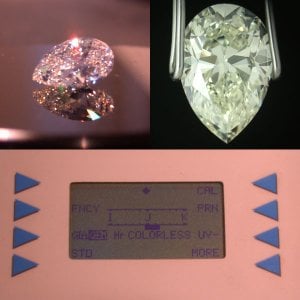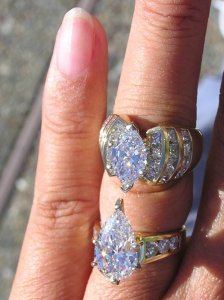You are using an out of date browser. It may not display this or other websites correctly.
You should upgrade or use an alternative browser.
You should upgrade or use an alternative browser.
Will a blue fluoresence make stone look whiter?
- Thread starter informer
- Start date
- Status
- Not open for further replies. Please create a new topic or request for this thread to be opened.
Face up - quite possibly in the medium to strong blue.Date: 6/1/2005 10:37:38 AM
Author:informer
I''ve been doing some reading and im a lil confused on the role of fluoresence. If placed in Plt or 18K WG, will the blue make an H or I stone (or even K) appear whiter?
does this occur only when sparkling or is there a noticible differnce with minimal light?
belle
Super_Ideal_Rock
- Joined
- Nov 19, 2004
- Messages
- 10,285
fluorescence doesn''t have a ''role'' it is a naturally occuring phenomenon in some diamonds. it is possible that the side effect of strong blue fluoroescnce, could offset the slight yellow color and make the stone appear ''whiter'', but that is not always true. the only guarantee you''ll get with fluorescence, is that your diamond will glow under blacklight conditions.


aljdewey
Ideal_Rock
- Joined
- Nov 25, 2002
- Messages
- 9,170
mrssalvo
Super_Ideal_Rock
- Joined
- Jan 3, 2005
- Messages
- 19,132
Your jeweler was right it MAY make a stone look cloudy or milky. It's a stone by stone thing. Many people including me actually prefer it and wouldn't buy a stone w/out it. If your up for a little reading here is a great thread that provides a lot of info link
Sunni79
Shiny_Rock
- Joined
- Feb 25, 2005
- Messages
- 239
I would think this could occur in colorless diamonds.Date: 6/1/2005 11:51:02 AM
Author: boo
A jeweller we visited recently explained that a blue fluorescence may make the diamond appear cloudy and less sparkly, I''m not sure if that''s accurate.
Nicrez
Ideal_Rock
- Joined
- Jan 21, 2004
- Messages
- 3,230
Fluorescence in diamonds is actually seen best in UV light, as others have stated. The reason it looks a bit different in daylight, is because daylight actually has a small component which is UV light. That UV light component causes the reaction of the fluorescence to show, even if it is to a smaller amount than under direct UV light. This chalky blue glow in the stone tends to show lighter, as a chalky color and the blue is really only seen lightly under UV light, generally. That is what the whiteness (chalkyness) is seen in daylight, masking the stone's yellowish body color.
If fluorescence is very strong, it may cause more than a slight white chalkiness, and look MILKY. A stone that is milky is usually VERY strong in fluorescence under UV light alone. Makes sense right?
Note: Some stones (rare) have different colors of fluorescence. I saw a diamond with strong yellow FL, and that was a unique looking stone. A very large majority have blue though, and GIA has estimated that about 35%+ of stones have slight to strong fluorescence under UV light.
Colors like G-J+ tend to cost more with fl, due to this unique "whitening" effect being faorable for buyer, BUT colorless stones above D-F are actually discounted when they have FL, because at that point the chance of being whiter is not favorable, it may cause more likely cloudiness at the V. Strong to possible Strong Fl levels.
If fluorescence is very strong, it may cause more than a slight white chalkiness, and look MILKY. A stone that is milky is usually VERY strong in fluorescence under UV light alone. Makes sense right?
Note: Some stones (rare) have different colors of fluorescence. I saw a diamond with strong yellow FL, and that was a unique looking stone. A very large majority have blue though, and GIA has estimated that about 35%+ of stones have slight to strong fluorescence under UV light.
Colors like G-J+ tend to cost more with fl, due to this unique "whitening" effect being faorable for buyer, BUT colorless stones above D-F are actually discounted when they have FL, because at that point the chance of being whiter is not favorable, it may cause more likely cloudiness at the V. Strong to possible Strong Fl levels.
- Joined
- Jul 12, 2004
- Messages
- 4,060
Nicrez
Ideal_Rock
- Joined
- Jan 21, 2004
- Messages
- 3,230
To properly view fluoresence, you should have a piece of clear Lexan.
To see if there is a visual affect, hold the stone in direct sunlight observe it, then pass the lexan above the stone, and see if you notice a change. If you do, you''ll be able to see the affect in an environment that it is commonly worn in.
Grading the affect of fluoresence is a stone by stone call. Sometimes it is a benefit, sometimes it is a detriment.
Rockdoc
To see if there is a visual affect, hold the stone in direct sunlight observe it, then pass the lexan above the stone, and see if you notice a change. If you do, you''ll be able to see the affect in an environment that it is commonly worn in.
Grading the affect of fluoresence is a stone by stone call. Sometimes it is a benefit, sometimes it is a detriment.
Rockdoc
- Joined
- Jul 12, 2004
- Messages
- 4,060
lumpkin
Ideal_Rock
- Joined
- May 24, 2005
- Messages
- 2,491
I just thought I''d drop my two cent''s worth. My pear is an M with very strong blue flourescence. I bought it from Abazias and they took some pictures of it for me before I purchased it. One of the pictures was of their colormeter''s "perception" (for lack of a better word) of the color. It showed it as a J but the GIA report says it is an M.
When I''m in sunlight or shade, the stone looks pretty nearly colorless. I''ve noticed that at the salon where there are color corrected flourescent lights, it clearly has a faint yellow tint. Comparing it side by side a colorless stone, it doesn''t "pop" like the colorless stone -- it is more subtle.
From just my own personal experience, not as an expert, it seems to hide a lot of the tint in many lighting conditions, but not all.

When I''m in sunlight or shade, the stone looks pretty nearly colorless. I''ve noticed that at the salon where there are color corrected flourescent lights, it clearly has a faint yellow tint. Comparing it side by side a colorless stone, it doesn''t "pop" like the colorless stone -- it is more subtle.
From just my own personal experience, not as an expert, it seems to hide a lot of the tint in many lighting conditions, but not all.

- Joined
- Aug 29, 2003
- Messages
- 15,808
H doesn''t need any help to look colorless...Date: 6/1/2005 10:37:38 AM
Author:informer
I''ve been doing some reading and im a lil confused on the role of fluoresence. If placed in Plt or 18K WG, will the blue make an H or I stone (or even K) appear whiter?
does this occur only when sparkling or is there a noticible differnce with minimal light?
A large I color for a senzitive viewer who does care allot about colorlessness would benefit from some help.
Now, K is at quite a distance from I (the color gardes become wider and wider ranges away from D-F; J-K is as wide a range as D-G as far as I know). Strong fluorescence would make that color turn on and off literally.
Of course, fluorescence does not act all the time: you need some ultraviolet light to produce the effect. Most light sources including daylight have it, but most indoor lighting is yellowish to begin with so it would show color and then some. Diamonds change face allot depending on lighting conditions, fluorescent diamonds even more so.
The phisics of diamond fluorescence are relatively straight forward. On the web, Adamasgem posts some very good material about it.
Just my 0.2

- Joined
- Aug 29, 2003
- Messages
- 15,808
Hi informer,
Yes blue fluorescence will make a stone look whiter. Some people on this forum actually choose to buy stones with fluorescence because they are cheaper and like the idea and look of it. Provided it does not make your stone look milky, I think it is a bonus for stones colored H and higher.
If you wanted to know the science behind it, I made a post here explaining the effects from an optical point of view.
-joycer
Yes blue fluorescence will make a stone look whiter. Some people on this forum actually choose to buy stones with fluorescence because they are cheaper and like the idea and look of it. Provided it does not make your stone look milky, I think it is a bonus for stones colored H and higher.
If you wanted to know the science behind it, I made a post here explaining the effects from an optical point of view.
-joycer
- Status
- Not open for further replies. Please create a new topic or request for this thread to be opened.
Share:
How Are Diamonds Made? Natural vs Lab-Created Explained How Are Diamonds Made? Natural vs Lab-Created Explained - 08/05
How Are Diamonds Made? Natural vs Lab-Created Explained - 08/05

Top Wedding Ring Brands for Every Style and Budget
Top Wedding Ring Brands for Every Style and Budget - 08/05
Where to Buy Lab Grown Diamonds: Best Places Compared
Where to Buy Lab Grown Diamonds: Best Places Compared - 08/05







300x240.png)